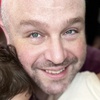PBS has ensnared American High, and they're showing all the episodes (including the first four that aired on Fox). One show featured Kaytee's music. The closing credits listed her last name: Bodle. After the show, looking for HPHS students in the PBS chat room, I found a sophomore who was a friend of: Billy Bodle. Bodle Shmodle, you say? Ah, but Mr. Bill Bodle was my strength coach in high school, the one who ran the no-nonsense Kong Room and taught me the basic principles of weight training. I asked the guy to tell Billy to tell his dad that I'm still doing Super Slow. Another chatter, who had been a freshman when I was a senior, recognized my name and remembered that I played the piano. He had heard of the Daily Jolt, and I tried to pitch it to him, but he didn't have time to run one himself. (Heck, when I was in college, I didn't either.) Ain't it beautiful how TV virtually brings people together?
Let's get pedantic!
After his workout, as Pedro was stretching, we looked at our progress on each exercise. I commented that my weight setting on the torso row machine was an order of magnitude higher than when I began: in base 10, from 40 to 100 pounds. Expressed in base 16, I went from 28 to 64 pounds. In observing that the base-16 numbers have equal numbers of digits, one can (and should) conclude that they also require the same power of the base to express their values. Which is one very good definition of “order of magnitude”. What conclusions can you draw from the fact that the two weights are different orders of magnitude in base 10, and the same order of magnitude in base 16? What if the weights were expressed in kilograms, grams, or some other unit? What if Earth's gravity were stronger or weaker?
As I sat on the train, for some reason — perhaps Pedro's youthful exuberance? — I started thinking about how children ought to be taught. Whether or not we call these subjects by their proper names, and regardless of how preposterous it might seem to teach them to kids, children learn mathematics, physics, and philosophy from a very early age. A child seeks patterns; mathematics is the study of patterns. A child asks how things work; physics is the study of how things work. A child wonders how to interpret his world; philosophy is the study of how humans interpret their world. Curious minds are wired for these subjects, and young minds are the most curious of all.
A teacher (for example, a parent) should explain that the child's questions are important, that adults think about the same things, and that many generations of people have thought about these things. A teacher should explain that adults have lots of big words to help them understand things, but that sometimes adults use those big words to make it sound like they understand things when they really don't. A teacher should explain the difference between a thing and what people call the thing. That knowing what other people call things is only important if you want to talk to other people about those things. That it's far more important to think about why water in a non-moving container has a flat surface and why this surface is parallel to the ground, than it is to know what the word “parallel” means (useful as it is).
Once the kid has thought about that, have him imagine that he's taking the container on a train and carefully holding it parallel to the ground. What happens to the surface of the water when the train speeds up? Slows down? Why? What would he have to do to keep the surface of the water parallel to the bottom of the container? How might this relate to the water in our non-moving container that was parallel to the ground?
A child who wonders about things like this, and sees that adults can too, will grow up to be that rare adult: one who never ceases to wonder.
